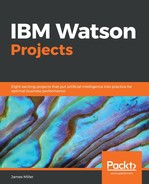In Chapter 6, we covered the concept of pattern recognition and using Watson Analytics to identify regularities in data to positionally classify athletes based upon data.
Key takeaways:
- Pattern recognition is the identification of patterns and regularities in data based on prior knowledge or the information extracted from the pattern.
- Pattern recognition is considered by some to be a matured but still exciting and fast-developing field, underpinning developments in cognate fields such as computer vision, image processing, text and document analysis, and even neural networks.
- An initial data review is an important step in any project, even if the review is simply a conversation with the data provider about some background and what might be expected to be in the file.
- Rather than performing an Add, Create New, (Explore), you can click on a panel in Watson Analytics to see suggested starting points to help explore the data through questioning. This method is sort of a quick start-version of the Watson Analytics Explore and shows the Here are some starting points for ... display.
- The Watson Analytics coach can be accessed by clicking on How to ask a question (shown in the upper right of the Here are some starting points for ... display page).
- The coach provides individual categories of questions, generated based upon the data which can be reviewed and selected from drop-down lists.
- When you have selected one of the questions, you'll see a new set of starting points.
- Under Select a category, there is a drop-down list of categories which includes a category named Understand relationships and identify patterns, which will show questions intending to help us use relationships in our data to identify patterns that may exist in it.
- Watson Analytics automatically identifies patterns and associations in the data and then lists new, relevant starting points based upon those findings. These starting points are gathered together and displayed on the Watson Analytics Insight Bar.
- The Insight Bar displays starting points so that they can be easily noticed, selected, and explored, if desired.
- If we click on a data point within a visualization, we are presented with a short menu that allows us to either Keep or Exclude that data point from the visualization. In addition, if you click on the 3-dot icon in the upper right of the menu, you can then see the extended version of that same menu.
- In addition, you can interact with a visualization using Create Calculation, Navigate/Compare, Go Up/Down, and Show by.
- A trend is the general direction of a data point over a period of time. A pattern is a series of data that repeats in a recognizable way.
You can just ask Watson by typing a question starting with What is the trend? - A prediction is a container for a predictive analysis and specifies the dataset that is being analyzed. A prediction can also specify field properties that override the field properties in the dataset.
- Each Watson Analytics prediction can have different targets and inputs. After you create a prediction, you then review it to see the output from the analysis.
- Data quality will directly affect the ability to reliably predict any outcome. In an attempt to ensure that a prediction is as strong as it can be, Watson Analytics uses a calculated representation of the data. This is known as the data quality score.
- The IBM Watson Analytics Data Quality Report provides both graphical and textual information about the quality of the dataset being used (as a whole as well as the individual fields in the data).
- The data quality score can be affected by missing values, constant values, imbalances, influential categories, outliers, and skewness.
